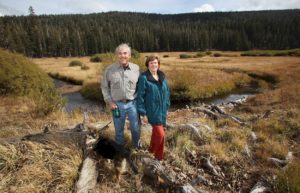
In 1993, well before I left my job as CEO of Applied Materials, my wife Becky and I started our family foundation. Giving brings us joy. At the same time, we thought giving locally was important in Silicon Valley, where great need exists alongside great wealth.
Becky and I wanted to identify good nonprofits and support their work. We sought to work directly with those who were involved in the spaces where we wanted to make a difference.
As a result, we became more active and involved givers—much like investors. Additionally, we founded two successful nonprofits: the Northern Sierra Partnership and California Stewardship Network.
Our shared goal was to see a measured return on our investments through lives changed and communities transformed. In particular, we hoped to see the impact of our philanthropy through:
- Having young people reach their educational goals and make responsible life choices.
- Protecting natural resources to aid in the balance of nature and to bring enjoyment to people today and in the future.
- Seeing issues thought to be intractable become manageable when addressed by regional stewards through collaboration.
buy avana online https://thatsleepguy.com/wp-content/uploads/2025/01/png/avana.html no prescription pharmacy
Becky and I are pleased and humbled by what the foundation has accomplished. Now, we are ready to pass the torch to the next generation of philanthropists. Last year, with mixed emotions, we announced that Morgan Family Foundation would wind down after almost 30 years. Over that time, we invested $150 million in the nonprofit sector, supporting dozens of local and regional organizations, and a few targeted areas internationally.
Here are some of the valuable lessons we learned in our nearly three decades operating the foundation:
Navigating Funder/Grantee Dynamics
- Respect grantees by not micromanaging. Understand that nonprofit staff are experts in their respective fields. Listen to what they’re telling you. It is critical to mission success.
- Consciously reduce the power dynamic that’s inherent in grantee-funder relationships by being approachable, asking questions and listening well.
- Be willing to tackle problems from a new angle. Learn and experiment alongside nonprofit partners.
buy zyban online https://thatsleepguy.com/wp-content/uploads/2025/01/png/zyban.html no prescription pharmacy
Nonprofits appreciate your ability to be bold, flexible and risk-ready.
buy symbicort online https://thatsleepguy.com/wp-content/uploads/2025/01/png/symbicort.html no prescription pharmacy - Carefully select which metrics to track and why. While data can tell an effective story, it can also de-humanize people. Likewise, requiring excessive data puts a burden on busy staff.
- Respect other people’s time. Simplify RFPs, and use conversations and visits to make decisions on granting funds.
- Identify the exit strategy for your grants. In order to help grantees avoid fiscal cliffs, step down support through multiyear exit plans when possible. Be clear and give ample warning when it’s time to stop grants to an organization, whatever the reason.
Grantmaking Takeaways
- The first and most important overarching task is getting crystal clear on the goal.
- Relationships built on trust are critical—leadership matters!
- Get buy-in from all nonprofit partners. And keep getting buy-in.
- Incentivize collaboration. Make it worthwhile for organizations to participate.
- Give ample support to backbone activities like leadership, management and operational development.
buy synthroid online https://thatsleepguy.com/wp-content/uploads/2025/01/png/synthroid.html no prescription pharmacy
- When big organizations work with smaller ones, understand there will be different bandwidth issues. Adjust accordingly.
- There’s strategic value in being the first grantor, the second grantor, the first co-grantor, etc. It’s easier to get buy-in from other funders for an initiative or organization at the beginning.
- Share credit. This will help the organization avoid the perception that its work belongs to a specific foundation (and therefore doesn’t need anyone else’s funding).
- Prepare for the long haul. There is power in perseverance and systems-level change takes time.
What’s Next?
Since winding the foundation down, I’m continuing to work on strengthening management and leadership skills in nonprofits, particularly among emerging leaders. In 2020, I published Applied Wisdom for the Nonprofit Sector, which highlights eight core management principles as they relate to nonprofits. We have distributed complimentary copies to hundreds of organizations across the United States, as well as and in 30 other countries. I also publish a weekly newsletter and blog.
About the Author
James C. Morgan is a nonprofit and philanthropic leader, based in Silicon Valley, who has worked extensively in the worlds of both for-profit and nonprofit organizations. You can find his website at www.appliedwisdomfornonprofits.org.

Quite insightful! This is the mindset that funders should embrace to unlock the impact of their grantees work. Kito International, my non profit in Kenya has been fortunate to work with funders who were more of partners and became invested beyond just giving grants and that really helped us in our work!